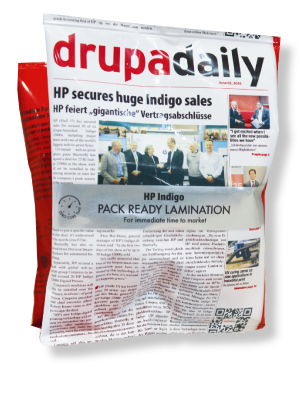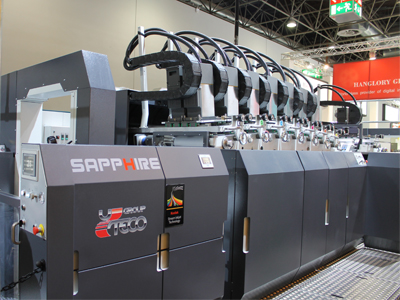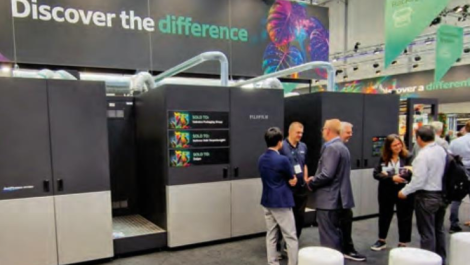Kodak inkjet printheads mounted onto Uteco transport for flexibles
Wow! Welcome large digital, to the packaging drupa. Just as label makers have done, high volume packaging converters must wake up to a new reality. Digital systems are drawing up their (metaphorical) tanks on your lawns. Sean Smyth reflects on drupa 2016.
Packaging is an attractive market segment for equipment and consumable suppliers. Continuing growth is forecast as populations rise and brand fragmentation continues, and there is no prospect of electronic substitution. The number of digital equipment suppliers offering packaging and label solutions is growing.
While drupa is not a label show, there was still plenty there. Domino reported over 60 installations of the narrow web N610 press, while Durst showed the Tau 330 inkjet press inline with a Spartanics laser cutter, boasting 60 installs in the last year, some for primary flexible packaging. HP Indigo has doubled productivity with the twin-engined 8000 press. Epson has launched its UV curing press, with the first three installs completing their beta testing. It also has a small inkjet printer that links with a Bluhm label applicator to provide a standalone solution to print and apply front and back labels.
The first EB curing narrow web inkjet lines were shown, promising thinner ink films eliminating photoinitiators that should result in food-safe print. Collins Inkjet has the inks; it is a compact drying unit that makes the technology a valid alternative to UV curing. This was demonstrated on the EBI stand, where a PPSI DICE inkjet line printed EB curing inks. The curing unit is some €200,000, with the payback from lower cost inks and reduced energy use.
Corrugated news
HP Indigo reinforced its market leadership in labels, and it is really making inroads elsewhere with the 20000 and 30000 packaging presses approaching 100 installations. HP sees opportunities for further growth in labels and is looking to develop the flexibles and carton sector, introducing new capabilities that will allow the early adopters to provide new services. It also has corrugated presence, reporting another two installations of the T400S corrugated liner press at Georgia Pacific and Ghelfi Ondulati. There is a new post-print press, the PageWide C500 Press that uses thermal heads with the option of the HDNA head architectures which significantly boosts the quality.
Another corrugated liner machine is the BHS Corrugated Maschinen und Anlagenbau GmbH and Screen partnership. They are setting up a new company to develop inkjet technology that will be integrated into a BHS corrugated line. This will integrate the core competencies in inkjet, engineering, web transport and manufacturing to develop the new industrial system, with the first alpha installation planned in 2018. It will be a 2.8 m wide single-pass print system, using aqueous inks with speeds up to 300 m/min, the only reel to printed sheet system, integral to the corrugated board manufacturing. BHS plans to sell the system as an option for new corrugators, or as upgrade to existing installations.
Bobst reported consistent progress on its inkjet corrugated press beta tests, with work underway to develop roll to roll carton and flexible packaging. As well as the Bobst and HP corrugated post-print lines, Durst, EFI and Barberàn all showed new sheetfed single pass inkjet post-print machines. Durst’s single pass Rho 130 SPC prints up to 9350 square metres per hour, using Durst Water Technology hybrid UV inks.

HP showed the capabilities of its Pack Ready concept
In other news
There were lots of new concept machines, with 2017 slated to be a busy year for new technology coming to the beta testing stages. Landa’s S10 will be one of these, with German carton converter ColorHouse one of the early adopters. Landa seem to have sorted out the technology, sheets look stunning and in seven colours, the gamut really is impressive. The digital guys have stopped trying to emulate process colour litho, they are going to use the capabilities of their colourants better – and in four colour, they deliver a wider range than offset or flexo inks. In seven colours even more with bright pillar box red, deep greens and even violets achievable. So while Benny Landa can say it is the death of the spot colour, he is probably exaggerating a little, special inks will still be needed. The 1 m wide web press, the W10, for flexibles was running without white, producing high quality output. Productivity of 200 m/min is attractive and the first order was placed by Reflex in the UK. The nano-metallisation technology, shown for the first time, promises environmental and sustainability benefits over traditional foiling.
Kodak showed the high quality Ultrastream technology for flexibles. They are talking to partners to bring it to market in future; for now you can buy Prosper heads on a Uteco flexo press in seven colours at 200 m/min, plus varnishing. The key is the primer that allows excellent adhesion and printability. Kodak highlights the excellent tension control, and dryer performance that has enabled the high quality output, while the water-based inks have gained food safe approval in Europe and North America. The Fujifilm EUCON uses LED-cured inkjet for flexible packaging in Japan, while it has water-based inks for the sector. The UV inks open new applications including high quality direct to metal, with inks providing full compatibility to can making, including shaping and sealing.
Xeikon reported progress under Flint’s ownership with Antoine Fady, CEO of Flint, presenting alongside Wim Maes. This included greater reach from the Flint sales and distribution channels, and importantly access to Flint financing solutions that will be useful for many converters. Integrated cutting and creasing for cartons was launched.
Konica Minolta showed its bizhub PRESS C71cf toner-based label system, while the B2 sheetfed KM-1 press has cartons as a target application. The stand also featured the B1 KM-C concept pressline, while Shoei Yamana, president and CEO, reiterated the importance of packaging as a future engine of growth for the company.
New entrants
There are new names entering digital packaging. Ricoh, Canon, Fujifilm and Xerox are now here (Xerox has been there for some time, with 60 automated packaging solution lines combining its iGen press with coater, cut and crease and folder/gluer for cartons in operation).
Xerox developments included direct to shape printing, for irregular shapes and late stage customisation using UV inkjet. The big news was the VariJET 106, a B1 inkjet press developed with KBA. The modular design integrates an inkjet unit into the KBA Rapida 106 platform, combining inkjet with optional inline capabilities including coating, cold foiling, die-cutting, creasing and perforating. Using inkjet adds challenges, particularly the transport cannot use a gripper mechanism, using a transfer belt.
Heidelberg showed its B1 simplex Primefire 106 inkjet press, with launch speed of 2500 sheets/hr and the first install slated for a carton producer next year. The third leading sheetfed litho press manufacturer, Komori, had its Landa nanography press, the Impremia NS40 alongside the UV inkjet B2 Impremia IS29.
EFI launched the Nozomi (named after the Japanese Bullet Train, the project codename that marketing could not better). This is a corrugated post-print machine, handling sheets up to 1.8 m wide at linear speed up to 75 m/min in seven colours. It should be commercially available in 2017.
In finishing
The show was strong in digital finishing equipment. Eliminating the die is a goal, while adding new features. Highcon’s Euclid III has pushed the productivity significantly, while LasX has a range of laser cutters linked to robotic handling. It has placed laser on a line from Italian supplier Petratta, combining die-less creasing and cutting. Sheets move into a double-creaser that mechanically creases across the full sheet in both directions, then through a LasX laser to cut out the final intricate shape, and to score crease lines that are not across the whole sheet, eg for tuck flaps.
While not really printing, the DataLase late-stage laser marking solution is gaining traction shown on Ricoh and Xerox stands, along with several inkmakers. Xerox featured the Macsa ID DIGILase, laser diode imaging that can print detailed graphic content onto pre-coated packages at high speed. The technology allows contactless late stage single colour imaging at filling or point of sale, with development to allow full colour.
As adoption of digital printing grows, it is apparent that printing must be linked to a whole infrastructure to provide the tools for converters to solve pain points and provide new features is necessary, such as PrintOS, HP’s cloud-based software that provides resources for users.
drupa showed lots of established packaging solutions, some becoming commercialised with futuristic concepts that are years away. Many orders were placed, demonstrating the demand and market pull for new
technology, exciting times!






